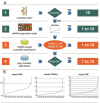A simplified interventional mapping system (SIMS) for the selection of combinations of targeted treatments in non-small cell lung cancer
- PMID: 25944621
- PMCID: PMC4546456
- DOI: 10.18632/oncotarget.3741
A simplified interventional mapping system (SIMS) for the selection of combinations of targeted treatments in non-small cell lung cancer
Abstract
Non-small cell lung cancer (NSCLC) is a leading cause of death worldwide. Targeted monotherapies produce high regression rates, albeit for limited patient subgroups, who inevitably succumb. We present a novel strategy for identifying customized combinations of triplets of targeted agents, utilizing a simplified interventional mapping system (SIMS) that merges knowledge about existent drugs and their impact on the hallmarks of cancer. Based on interrogation of matched lung tumor and normal tissue using targeted genomic sequencing, copy number variation, transcriptomics, and miRNA expression, the activation status of 24 interventional nodes was elucidated. An algorithm was developed to create a scoring system that enables ranking of the activated interventional nodes for each patient. Based on the trends of co-activation at interventional points, combinations of drug triplets were defined in order to overcome resistance. This methodology will inform a prospective trial to be conducted by the WIN consortium, aiming to significantly impact survival in metastatic NSCLC and other malignancies.
Keywords: NSCLC; algorithm; pathway; targeted therapies; tri-therapy.
Conflict of interest statement
Razelle Kurzrock receives consultant fees from Sequenom and is a founder of Rscuerx
Figures



References
-
- Siegel R, Ma J, Zou Z, Jemal A. Cancer statistics. CA Cancer J Clin. 2014;64:9–29. Cancer of the Lung and Bronchus - SEER Stat Fact Sheets http://seer.cancer.gov/statfacts/html/lungb.html 2014. - PubMed
-
- American Lung Association. Lung Cancer Fact Sheet. 2015 http://www.lung.org/lung-disease/lung-cancer/resources/facts-figures/lun...
-
- Sequist LV, Martins RG, Spigel D, Grunberg SM, Spira A, Jänne PA, Joshi VA, McCollum D, Evans TL, Muzikansky A, Kuhlmann GL, Han M, Goldberg JS, et al. First-line gefitinib in patients with advanced non-small-cell lung cancer harboring somatic EGFR mutations. J Clin Oncol. 2008;26:2442–9. - PubMed
Publication types
MeSH terms
LinkOut - more resources
Full Text Sources
Other Literature Sources
Medical
Miscellaneous

